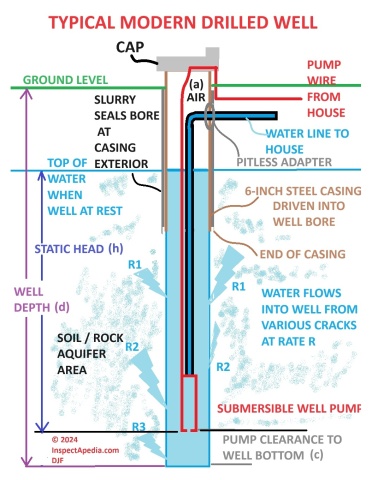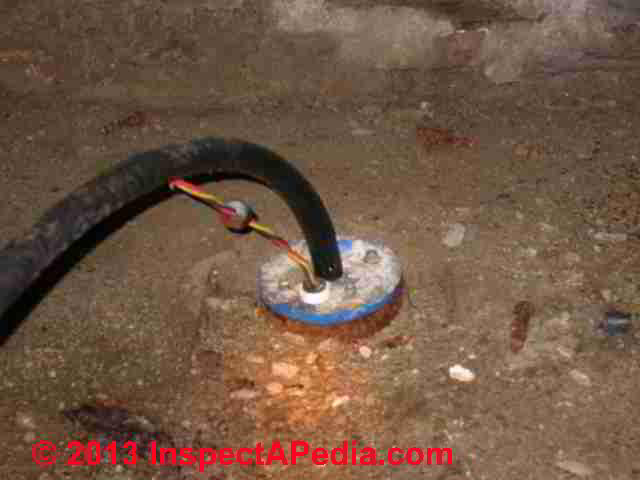 Pitless Adapters for Steel Casing Water Wells
Pitless Adapters for Steel Casing Water Wells
What is a pitless adapter, why are they used
How is the pitless adapter installed
Types of pitless adapters
Pitless adapter sources, manufacturers
Top clamps/seals for pipes exiting well casing top
- POST a QUESTION or COMMENT about pitless adapters & steel casing drilled water wells at residential properties
Well piping pitless adapters:
This article defines the pitless adapter and explains the use of the pitless adapter on drilled wells that use a steel well casing, modern drinking water wells.
The pitless adapter allows passage of well piping out through the side of a well casing at a point underground and without leaks where the pipe passes through the round well casing side.
Why is it "pitless"? Because using a well piping pitless adapter eliminates the need for a well pit to protect pipes from freezing.
The pitless adapter also permits pulling out of well piping, foot valves, and submersible pumps directly through the top of the well casing. Our page top photo shows a not-very-deep installation of a pitless adapter during parts replacement.
InspectAPedia tolerates no conflicts of interest. We have no relationship with advertisers, products, or services discussed at this website.
- Daniel Friedman, Publisher/Editor/Author - See WHO ARE WE?
Pitless Adapter for Drilled Wells
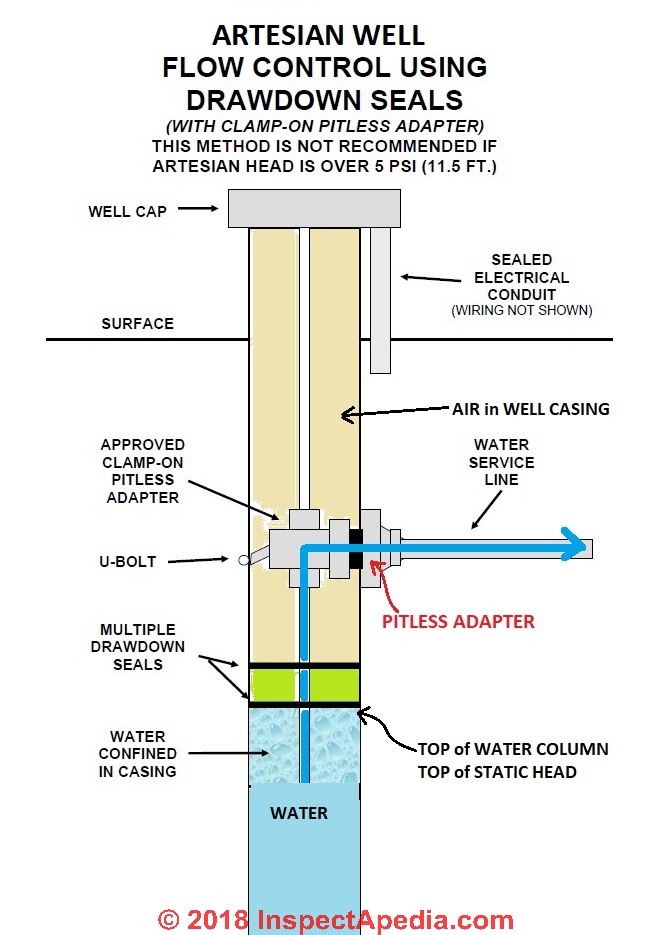 The water pipe leaving this well to carry water to the building will be buried below ground,
and in freezing climates, below the frost line.
The water pipe leaving this well to carry water to the building will be buried below ground,
and in freezing climates, below the frost line.
A special fitting, the "pitless adapter" is used to seal the passage cut into the round well casing to permit the water piping to pass through the casing and out to the building it serves.
Our illustration at page top and at left shows a low-pressure well spool using a clamp-on pitless adapter in a design suitable for artesian wells whose head pressure is equal to or less than 5 psi (a head of 11.5 ft.) - courtesy Michigan DEP. Similar pitless adapter fittings accommodate other well casing and piping designs.
Other clamp type fittings used at the top of a well casing may be used to seal the well top around piping that exits at the top rather than the side of the well casing.
This approach is suitable only in non-freezing climates or where the well head is protected from freezing by its location such as in a well pit or inside of a heated structure.
One of our readers was having trouble pulling the pump and piping up out of their well - the pump jammed in the casing near the top of the well. We wondered if the pump was unable to pass by the pitless adapter since this fitting intrudes into the well casing.
Most modern drilled wells for residential properties use a 6" steel casing which is inserted into the drilled hole prepared by the well driller and then sealed at top and bottom against contamination by surface water or surface runoff.
The best way to locate a well and well casing to avoid surface water contamination is shown in this illustration.
You can figure on about 1.5 gallons per foot of depth of a well using a 6" well casing - but remember you have to find the height of water column available to the pump.
Except in certain artesian walls the water column does not extend from the well bottom to the top of the ground.
Key to our sketch of the parts and features a drilled water well
In my ugly well parts sketch shown above I've marked the pitless adapter location showing where the well piping leaves the well casing through the casing side.
- d = well depth as drilled. More about measuring the depth of a well is
at DEPTH of a WELL, HOW TO MEASURE
- a = air - the distance from the ground surface to the top of the water when the well is at rest and is fully "recovered" from recent use
- c = clearance distance between the bottom of the well pump (or foot valve) and the very bottom of the drilled well. this distance is required to avoid having the pump pick up mud and debris from the well bottom.
- h = static head: the volume of water available to the well pump when the well is at rest and is fully recovered.
What's cool about most pitless adapters used on water wells is that inside the well casing the component of the pitless adapter that attaches to the top of the well piping is designed to simply slide up and out of the remaining pitless adapter parts bolted and sealed to the casing side.
This feature is what allows us to pull the well piping and submersible pump or foot valve completely out of the well without having to dig up and expose and disassemble the pitless adapter from outside the well.
Our photo (above-left) shows the mating face of a pitless adapter just after the well driller pulled the well piping and pitless adapter slip fitting up out of an existing well.
This well installation was in Two Harbors, Minnesota where the freeze depth can be so severe that many installers put the pitless adapter eight feet below the ground surface to be sure it and the exiting well piping are below the frost line.
This pitless adapter was not leaking, but this is a place we'd check for leaks if we were looking for a leak in well piping.
See WELL PIPING LEAK DIAGNOSIS
Parts of a Slide-type Pitless Adapter for Wells & How they Work
Below, using a 1-inch 304 Stainless Steel pitless adapter sold by AquaScience.net for about $80. U.S., we can see the parts of a pitless adapter more closely.
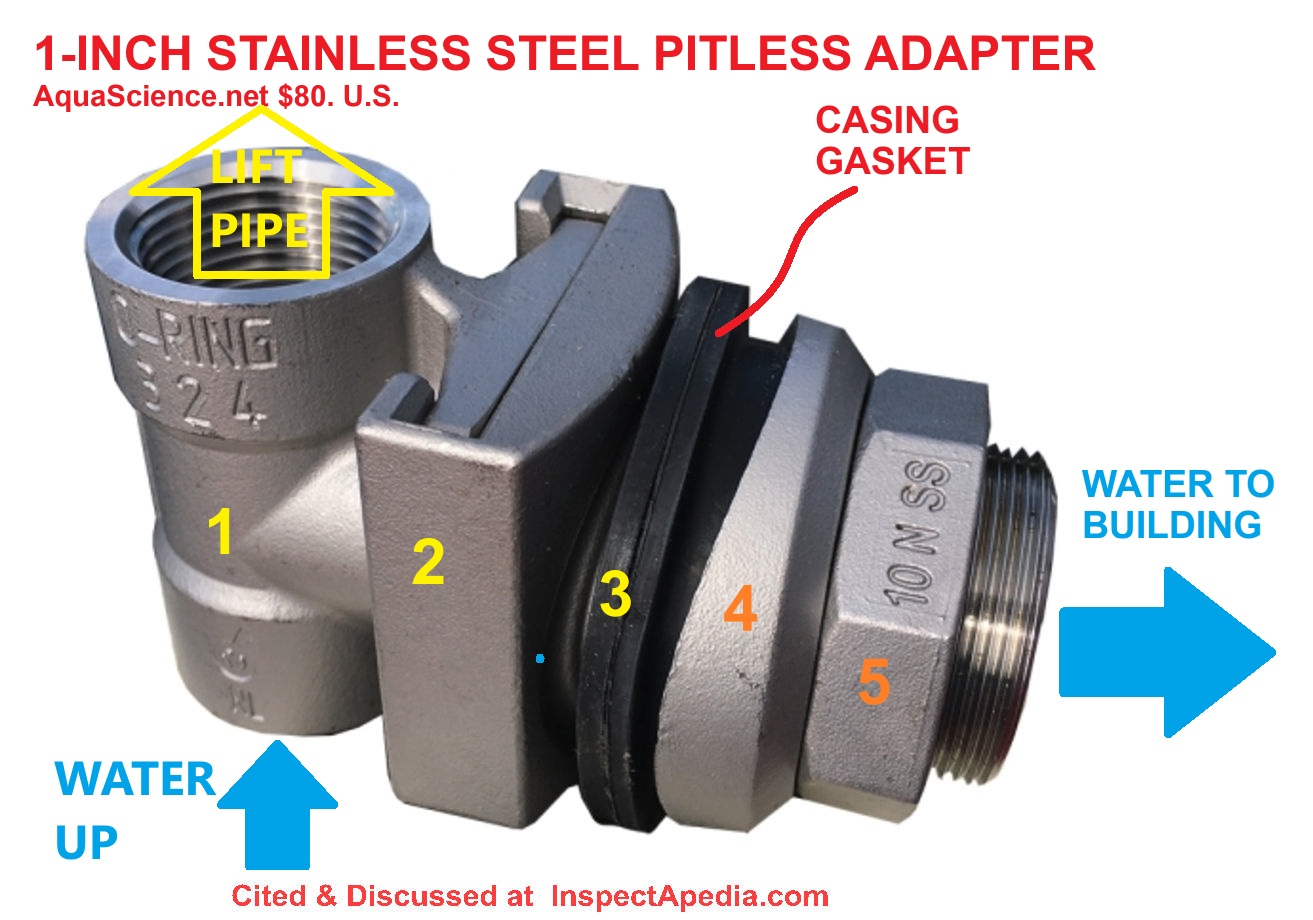
Naming parts from left to right beginning with what's inside the well casing:
- This is the removable part of the in-casing side of the pitless adapter.
To the top of this fitting is screwed a lift pipe, also referred to as a "pull pipe" or "drop pipe," to permit the pitless adapter and well piping to be raised or lowered into or out of the well.
When the well pipe and pitless adapter part #1 are lowered into the well the installer slides this fitting into part 2.
To the bottom of this fitting the well water supply pipe is connected (blue arrow pointing up) to permit the submersible pump to send water up to the building. - This fitting is bolted inside the well casing during installation and sealed against the casing wall by gasket 3
- The pitless adapter gasket seals between parts 2 and 4 to permit the curved parts to seal against the curved interior and exterior of the round steel well casing or "pipe"
This is a two-part gasket, one fitting against the inner surface of the well casing, and the second fitting against the outer surface of the casing. - This is the external fitting mounted to the outside of the well casing and curved to mold itself and the gasket (3) to the well casing exterior wall.
- This is the tightening nut that screws against the threaded pipe nipple end of part (2) to tighten the parts together against the well casing wall.
The water service line (pipe) that continues into the building is connected to the exposed male threaded end shown in our photo where the blue arrow points out the direction of well water being pumped to the building served by this well.
Pitless adapters are sold in other designs but all work similarly to provide a water tight seal between the below-ground pipe connections to the well and the rounded surfaces of the well casing.
On larger diameter well casings, instead of using the slide-type pitless adapter shown above, the well installer/plumber will use a spool-type pitless adapter (shown below).
Both types of pitless adapter permit easy installation and removal of the well piping.
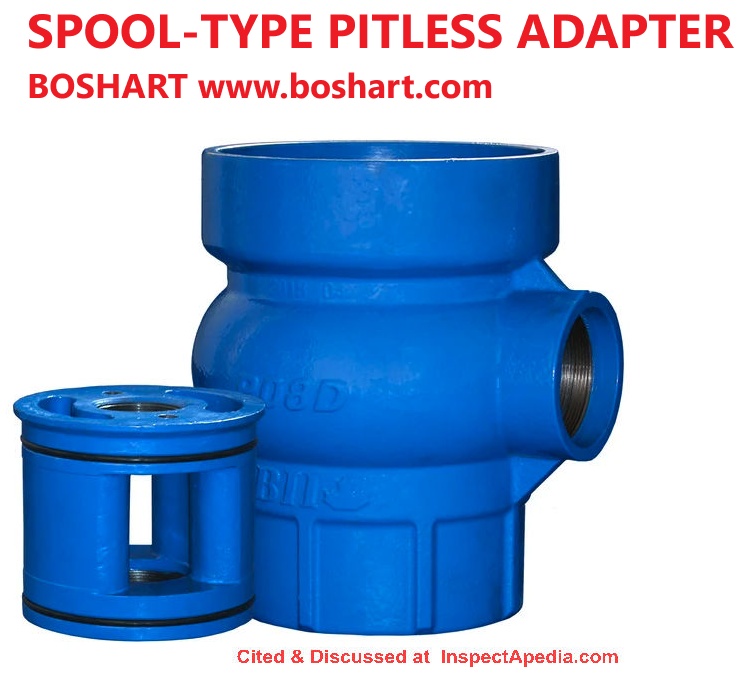
Examples of Pitless Adapter Manufacturers & Types
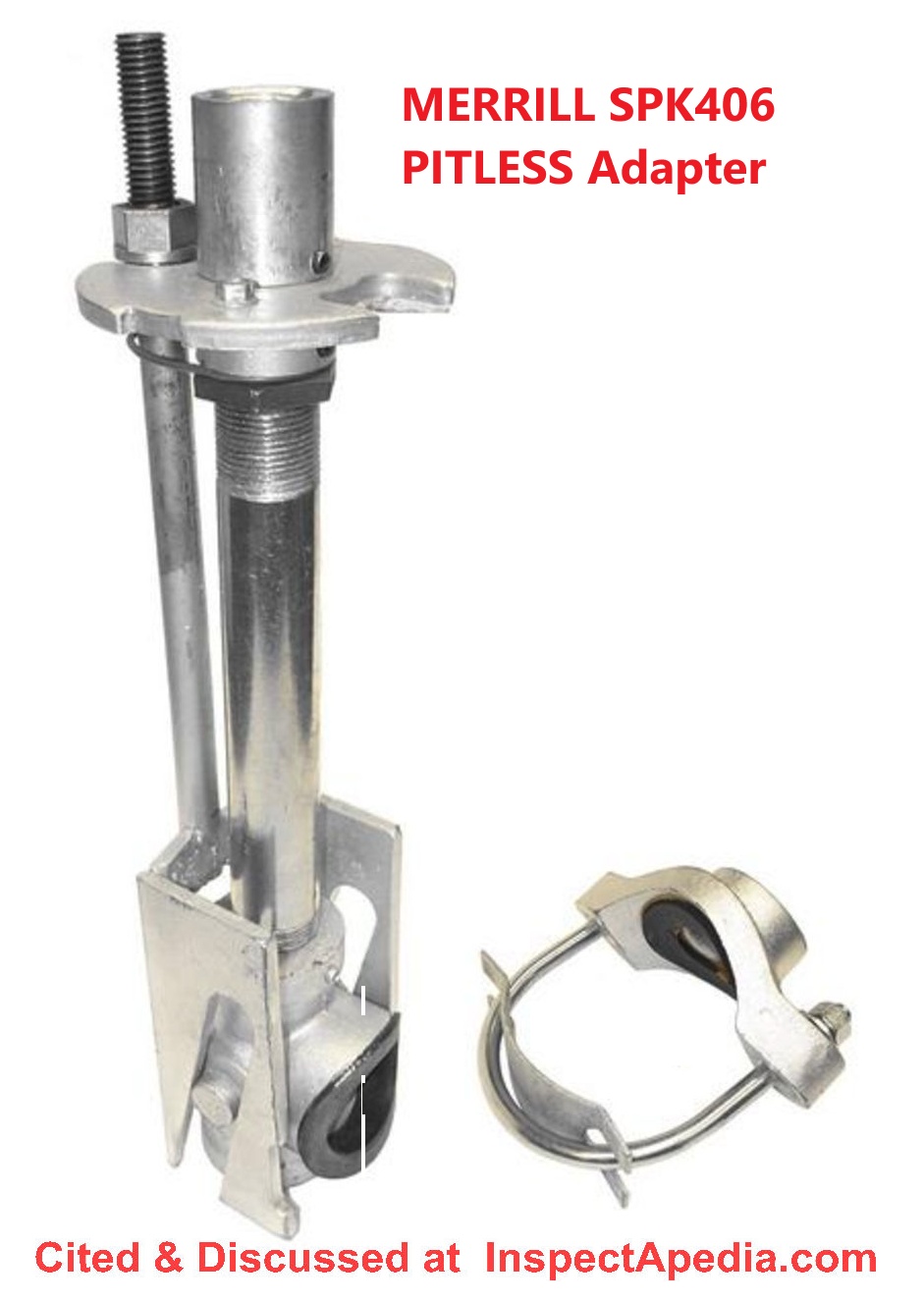
- Aqua Science No-Lead brass pitless adapters
- Boshart Industries, 25 Whaley Ave , Milverton, ON N0K 1M0, Canada Web: https://boshart.com/ Tel: 800.561.3164
519.595.4444 - Bronze Pitless Adapter PA-125NL sold at various pipe diameters as well as other pitless adapter sizes and types - also helpful for more detail is this
WATER WELL SLIDE vs SPOOL PITLESS ADAPTERS: WHAT'S THE DIFFERENCE [Web page] - Boshart
- Merrill Manufacturing, 315 Flindt Dr. PO Box 392 Storm Lake, IA 50588 USA Web: https://www.merrillmfg.com/ Tel: 800-831-6962 - e.g. Merrill SPK406 pitless adapters (shown above) can fit well casings from 4" in diameter and larger.
- PVC Spool pitless adapters are also available such as the FrezeFlow from Hoeptner Products.
- RPS Water Pumps Co., 40250 County Road 27, Woodland CA 95776 USA, Web: https://www.rpswaterpumps.com/ Tel: (855) 560-5670 - Well Seals provides stainless steel well seals
Well Casing Top Clamp Fittings Seal Around Well Piping, Wiring, Vents
Other clamp type fittings used at the top of a well casing may be used to seal the well top around piping that exits at the top rather than the side of the well casing.
This approach is suitable only in non-freezing climates or where the well head is protected from freezing by its location such as in a well pit or inside of a heated structure.
Our photo above shows a top-sealed well casing that is designed to permit a single well pipe and some wiring to pass out of the top of the well casing.
This well was located indoors in a New York home - not a great idea - in the building basement. From what we see, a single water pipe exiting the well and wiring entering the well, we expect to find a submersible well pump installed here.
Our second photo (above) shows how a compression type well casing top seal works: bolts tightened through the outside top of the seal compress a rubber gasket between two steel plates.
The expanding rubber gasket seals around pipes, wiring conduit, or whatever fittings were designed to pass through this well cap.
This well casing top was installed in Two Harbors MN.
Below we illustrate a conventional sealing well casing top cap used where only electrical conduit must enter the well casing above ground. At this well the water pipe exits below ground using a pitless adapter.
Also see SUBMERSIBLE PUMP.
Pitless adapters: buy, install, specifications
- Pitless Adapter Installation, Merrill, 315 Flindt Drive, PO Box 392, Storm Lake, IA 50588-0392 Tel: 800-831-6962 Website: www.merrillmfg.com
- Also seeReferences or Citations
...
Reader Comments, Questions & Answers About The Article Above
Below you will find questions and answers previously posted on this page at its page bottom reader comment box.
Reader Q&A - also see RECOMMENDED ARTICLES & FAQs
Galvanic corrosion of plumbing parts led to leaks at pitless adapter on our well
My water line out to the well casing became leaky to the extent that water continuously flooded the area near the casing.
After digging down past the pittless adapter a leak was revealed at the junction of the brass nipple to the coupling going into the pitless. Corrosion was clear on the brass pipe fitting but not the coupling.
I took a look on the galvanic chart to consider what the effect might be on brass (pipe fitting), silicon brass (coupling) and iron (well casing).
It appeared to me clear that the brass pipe was lower that the silicon brass on the corrosion chart and was therefore going to give itself up to corrosion to protect the silicon brass.
I think that the thing to be learned here is to be sure to use silicon brass in all parts between the plastic pipe and the well casing. Otherwise the problem is likely to repeat itself. - On 2018-08-23
by George Schwartze -
Reply by (mod) -
Thank you for the important and interesting point, George, I'll be sure it's kept with the article here and in our article series on galvanic corrosion of plumbing parts.
I suspect that since brass coupled to si-Brass should work without significant galvanic corrosion, that water chemistry in the soil or in the well was a factor.
See GALVANIC SCALE & METAL CORROSION at https://inspectapedia.com/BestPractices/Galvanic_Scale_Corrosion.php
You might want your well water tested for aggressiveness - get its corrosivity index.
Let us know what you find.
Pitless adapters differ for steel vs plastic well casings?
is there a diifference between a steel and plastic casing pitless adapters - On 2018-02-04 by salli -
Reply by (mod) -
Other than the obvious difference in materials I would not expect a plastic pitless adapter to be used with iron or metal well piping
Why does my well freeze at the pitless adapter in very cold weather?
My well line freezes at the pitless adapter everytime it gets 0 or below.
I pour a gallon of warm water down the well to thaw it out and it works fine until the next night.
If I put a heat tape on a piece of pipe and let it down to the pitless it wont freeze.
Is there a reason this is happening, no one else I know has this problem, is there something I can do permanently to fix the problem. thanks On 2017-12-29
by Dan ONeil -
Reply by (mod) -
Most likely your pitles adapter is not below the frost line
Do I need a pitless adapter on my well if we are not in a freezing climate?
Do i need a pitless adapter for a well is in a non freeze zone? On 2017-12-12 2 by CM -
Reply by (mod) - yes if your well pipes exit the casing underground
CM
Yes IF your well pipe exits the well casing underground.
No if your well pipe exits the casing at a casing top that is above ground.
Reader Question: how do I protect the well water piping in the well from freezing?
When draining the water from a dwelling that is allowed to freeze, how does the water supply from the submersible pump, supplied with foot valve, drain so the at or above grade pipes don't freeze and break? - Nate
Reply: well piping and pitless adapter should be below the frost line
Nate: see these articles on preventing well piping freeze problems
- DRAIN BACK & SNIFTER VALVE SYSTEM COMPONENTS - drain-back systems remove water from well piping that might otherwise freeze
- PIPE FREEZE-UP POINTS - where water suppy systems tend to freeze-up
- WELL PIPING PITLESS ADAPTER permit well piping to exit the well casing below the frost line
- WELL PITS are also sued to keep the well head below the frost line
Freeze protection for the submersible-pump well: in a modern submersible pump or even jet pump drilled well with a steel casing, the water line exits the side of the casing below the frost line (through the pitless adapter). The well piping too, should be buried below the frost line. If well piping is too shallow, indeed it may freeze up in very cold weather.
Water piping exiting older wells in some areas were protected from freezing by constructing a well pit that kept the well head far enough below the ground surface to avoid freeze-ups. But well pits can still permit a freeze-up in prolonged and very cold weather.
Operators & owners of buildings served by well pits typically provide a small heat source in the well pit to keep temperatures above freezing. Sometimes a simple light bulb is enough.
More tips about protecting a building from freeze damage are organized at WINTERIZE A BUILDING.
Question: what's the best tool for cutting the well-casing hole for a pitless adapter?
What happens to the metal filings when the hole is drilled for the pitless adapter?
What is the best hole saw to use for drilling a hole for a pitless adapter ? (Apr 28, 2016) George said:
Reply: details on drilling the well casing hole to install a pitless adapter
George:
A bit of metal debris probably falls into the well when the pitless adapter hole is cut using a metal hole saw or a welding torch.
Provided the pump is several feet or more above well bottom (as is normal to avoid sucking up mud and dirt), that debris ought to be harmless.
According to Merrill who produce pitless adapters and kindly publish pitless adapter installation instructions, the usual installation procedure follows these steps:
- The hole should be drilled in the well casing on the casing side facing the direction that the well pipe will run from the well to the building it serves.
- A center punch marks the spot for the pitless adapter installation. In a freezing climate that needs to be below the frost line.
For a two-hole pitless adapter (used with 2-line jet pumps) you'll need to inscribe a vertical line down the casing and to measure the proper distance between two center punches so that the two drilled holes will be located correctly to fit the two-hole pitless adapter.
- Select a hole saw of the appropriate diameter for the pitless adapter to be installed into the well casing. Hole diameters for pitless adapters range from 1 3/4" to 3" in diameter.
Naturally you'll use a hole saw with teeth and metallurgy designed for metal drilling.
Use a hole saw that includes a pilot bit that centers on that punch you used as we describe above.
The manufacturer of your pitless adapter will provide a table of well casing hole size diameters required for each model of pitless adapter.- For installing the pitless adapter fitting themselves the manufacturers provide additional details on lowering the female side of the pitless adapter (attached to descending well pipes) to the proper location in the well and you may also want special wrenches provided by the manufacturer to install the external pitless adapter fittings from outside the well casing.
A "pull pipe" is attached to the top of the in-casing side of the pitless adapter and is used to lower the assembly into the well.
Basically the male and female parts of the new pitless adapter are installed atop the drop pipe that will be lowered into the well.
For a submersible pump the pump is attached to the bottom of the drop pipe. For a 2-line jet pump the two well pipes and foot valve are attached to the pair of drop pipes.
A "female" o-ring seals the face of the in-casing female adapter to the interior side of the well casing and the nose of the female adapter is pushed out through the hole you drilled in the casing.
Outside the well casing a gasket, back plate and finally lock nut are installed onto the pitless adapter so that it can be connected to pipe(s) connecting the well piping to the building it serves.
...
Continue reading at WELL PITS, or select a topic from the closely-related articles below, or see the complete ARTICLE INDEX.
Or see these
Recommended Articles
- DRILLED WELLS, STEEL CASINGS
- PIPE FREEZE-UP POINTS - where water suppy systems tend to freeze-up
- WELL PIPE RETRIEVAL TOOLS
- WELL PIPING PITLESS ADAPTER
- WELL PITS - housing the well and often water tank, pump and controls
Suggested citation for this web page
WELL PIPING PITLESS ADAPTER at InspectApedia.com - online encyclopedia of building & environmental inspection, testing, diagnosis, repair, & problem prevention advice.
Or see this
INDEX to RELATED ARTICLES: ARTICLE INDEX to WATER SUPPLY, PUMPS TANKS WELLS & SPRINGS
Or use the SEARCH BOX found below to Ask a Question or Search InspectApedia
Ask a Question or Search InspectApedia
Questions & answers or comments about steel casing drilled water wells at residential properties.
Try the search box just below, or if you prefer, post a question or comment in the Comments box below and we will respond promptly.
Search the InspectApedia website
Note: appearance of your Comment below may be delayed: if your comment contains an image, photograph, web link, or text that looks to the software as if it might be a web link, your posting will appear after it has been approved by a moderator. Apologies for the delay.
Only one image can be added per comment but you can post as many comments, and therefore images, as you like.
You will not receive a notification when a response to your question has been posted.
Please bookmark this page to make it easy for you to check back for our response.
IF above you see "Comment Form is loading comments..." then COMMENT BOX - countable.ca / bawkbox.com IS NOT WORKING.
In any case you are welcome to send an email directly to us at InspectApedia.com at editor@inspectApedia.com
We'll reply to you directly. Please help us help you by noting, in your email, the URL of the InspectApedia page where you wanted to comment.
Citations & References
In addition to any citations in the article above, a full list is available on request.
- Access Water Energy, PO Box 2061, Moorabbin, VIC 3189, Australia, Tel: 1300 797 758, email: sales@accesswater.com.au Website: http://www.accesswater.com.au/
Moorabbin Office: Kingston Trade Centre, 100 Cochranes Rd, Moorabbin, VIC 3189
Australian supplier of: Greywater systems, Solar power to grid packages, Edwards solar systems, Vulcan compact solar systems, water & solar system pumps & controls, and a wide rage of above ground & under ground water storage tanks: concrete, steel, plastic, modular, and bladder storage tanks. - Grove Electric, Typical Shallow Well One Line Jet Pump Installation [PDF], Grove Electric, G&G Electric & Plumbing, 1900 NE 78th St., Suite 101, Vancouver WA 98665 www.grovelectric.com - web search -7/15/2010 original source: http://www.groverelectric.com/howto/38_Typical%20Jet%20Pump%20Installation.pdf
- Grove Electric, Typical Deep Well Two Line Jet Pump Installation [PDF], Grove Electric, G&G Electric & Plumbing, 1900 NE 78th St., Suite 101, Vancouver WA 98665 www.grovelectric.com - web search -7/15/2010 original source: http://www.groverelectric.com/howto/38_Typical%20Jet%20Pump%20Installation.pdf
- In addition to citations & references found in this article, see the research citations given at the end of the related articles found at our suggested
CONTINUE READING or RECOMMENDED ARTICLES.
- Carson, Dunlop & Associates Ltd., 120 Carlton Street Suite 407, Toronto ON M5A 4K2. Tel: (416) 964-9415 1-800-268-7070 Email: info@carsondunlop.com. Alan Carson is a past president of ASHI, the American Society of Home Inspectors.
Thanks to Alan Carson and Bob Dunlop, for permission for InspectAPedia to use text excerpts from The HOME REFERENCE BOOK - the Encyclopedia of Homes and to use illustrations from The ILLUSTRATED HOME .
Carson Dunlop Associates provides extensive home inspection education and report writing material. In gratitude we provide links to tsome Carson Dunlop Associates products and services.


